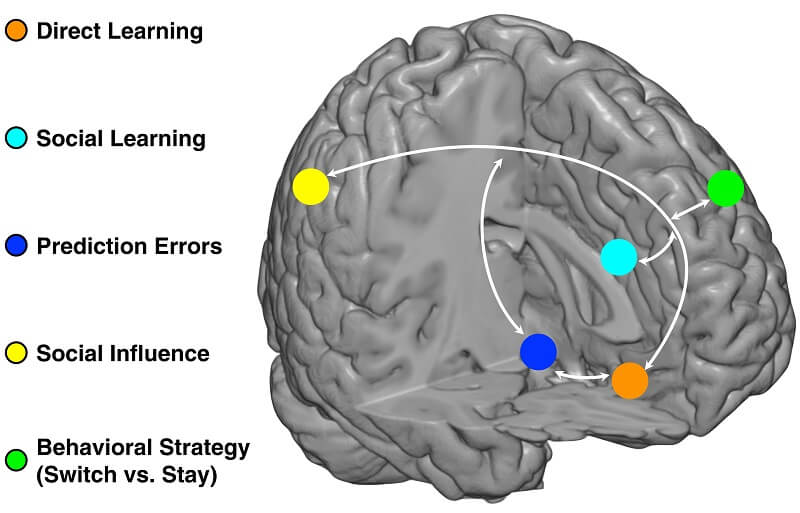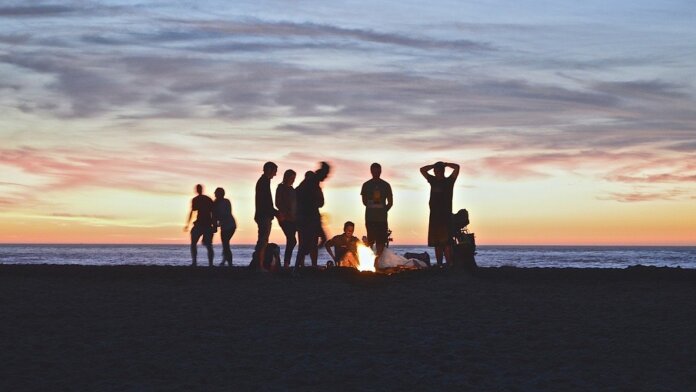I’m a doormat when it comes to peer pressure. Jump off a 32-foot (10 meter) diving board without any experience? Sure! Propel off a cliff my first time outdoor climbing? I’ll try!
Those were obviously terrible decisions for someone afraid of heights, and each ended with “I really should’ve known better.” But it illustrates a point: it’s obvious that our decisions don’t solely come from our own experiences. From what career you choose to what sandwich you want for lunch, we care about what our friends, families, and complete strangers think—otherwise, Yelp wouldn’t exist.
In academic speak, observing and learning from other people is called “social influence,” a term that’s obviously crossed into pop culture lexicon. Yet neuroscientists have struggled to understand why this happens. How do our brains process others’ decisions? And how does it weigh those decisions against our (potentially saner) judgment?
This month, Drs. Lei Zhang and Jan Gläscher from Germany and Austria teased out the neural networks that allow us to evaluate social influence. They then figured out how those networks link to our internal, or “direct” learning networks—that is, should I listen to my fear of heights or to social pressure?
By scanning the brains of 39 people playing a multiplayer betting game, the team synthesized a “social prediction error” from brain activity in the reward circuit, which measures the difference between how we expect people to behave versus how they actually do. They then used neurocomputational tools to model these brain activity data, and found a link between the brain’s reward circuit and social ones.
It’s not all academic curiosity. One of the most prominent AI models today, deep reinforcement learning, stemmed from research on how humans learn from their mistakes—formally known as “reward prediction error.” (Sound familiar?) As momentum gains for a more cognitive and social approach for training AI, neuroscience studies that help us understand how we learn from one another may also benefit learning algorithms that teach AI to learn by observing us.
Our work shows that we need to constantly balance our own expectations with those we observe in others, and whether the two match up, the authors concluded. Thanks to our brain’s social error signal, we can flexibly adapt our choices to social influence, maybe for the better.
Error! Bail!
Let’s talk direct learning first—the type of learning we gain from our own experiences. At its heart is the reward prediction error, and even if you haven’t heard of it, you’ve experienced it.
Take this scenario: you’re meeting your spouse’s coworkers for the first time. You have an expectation based on what you’ve heard, and you adjust your mannerisms appropriately…or so you think. When you meet them, you realized they’re nothing like what you expected.
This is where the reward prediction error comes in. We often hear about the brain’s “reward circuits,” but that’s not quite accurate. They don’t shell out pleasant reward rushes all the time. What these brain circuits actually do is calculate an estimated reward, based on your knowledge, expectations, and decisions, versus what actually happens.
If they match up, the reward error is very low, meaning your brain says that you don’t need to adjust your behavior. You also get a nice dose of happy-feeling neurochemicals to reinforce those behaviors; hence, reinforcement learning. If expectation and reality don’t match up, then the error is high—and that’s when you figure out you probably need to change your strategy.
In other words, you learn. At its root, reinforcement learning is learning from your mistakes in judgment.
Neuroanatomy studies have traced these learning circuits to two main regions: part of the prefrontal cortex (vmPFC), at the very forefront of your brain, which encodes your own valuation or judgment, and parts of the “reward” learning circuit, which encodes the error signal.
Influencer in the Lab
Social influence gets messier. Previous studies suggest that vmPFC is also involved in decision-making that incorporates social influence, but so far few people have traced how one mind can change another’s decision.
The team began answering these questions with 185 people, randomly assigned into groups of 5, in a social influence test. It starts with direct learning: people choose between two abstract fractal images—a yellow swirl and a blue snowflake—on a computer screen, with one choice getting a higher score than the other. They also laid down bets on how confident they were in their choice. The person was then able to see others’ choices in their groups sequentially, and was then provided with a second chance to choose.
The study “required participants to learn and continuously relearn,” the authors explained, so that they begin to naturally incorporate other peoples’ choices into their own decisions—even when they know that there is no bonus for participation or competition. Perhaps unsurprisingly, people were more eager to change their choice when it didn’t fit with the group’s, while sticking to their guns when it matched with the general flow. What’s more, if the person’s choice matched the group’s, they were also willing to bet higher on its chance of success in the next round.
Social information altered people’s choice and their confidence in the choice, which helped them readjust their choice next time around—an obvious sign of learning, the authors said.
The Brain’s Influencer Nodes
During the betting game, one of five participants laid inside an MRI machine and had their brains scanned. Altogether, the team watched the brain activity of 39 people as they grappled with sticking with their choice or succumbing to peer pressure.
Using their model to analyze MRI data, the team honed in on a brain region called the anterior cingulate cortex (ACC), which was previously found to track a sense of “good will” that we allocate to other humans. The ACC was particularly responsible for learning from others. Digging deeper, the team found the link between the two nodes: vmPFC, for direct learning, and ACC, for social learning.

The bridge is the putamen (Latin for “nutshell”), a round nugget of brain tissue that forms the broader reward circuit, which extends to a surface region of the brain (rTPJ, or right temporoparietal junction) that seem to be involved in immediate social influence. As for “should I stay or should I go?” in picking a choice, the ACC hooks up with another part of the prefrontal cortex, the dlPFC, to finally decide.
If your eyes are glazing over these acronyms, yeah, me too. Here it is in a nutshell (lol): the brain region that governs how we learn from our own experience is connected with ones that help us learn from the experiences of others. When the two circuits strongly sync up, we’re likely to change our behavior due to social influencers. But the final decision is still up to us.
Similar to learning from our own experiences, this social learning circuit generates a “social prediction error”—one that heavily guides how we learn from others, but surprisingly, also how we learn from ourselves. Both errors silently drive our next decision: what sandwich to get (listen to my own tastes or depend on Yelp?), what advice to take, and yeah—whether to jump off a diving board while freaking out from peer pressure.
“Direct learning is efficient in stable situations,” explains Gläscher, “and when situations are changing and uncertain, social learning may play an important role together with direct learning to adapt to novel situations.”
Now that we better understand brain networks for social learning, the next step is “disrupt them using non-invasive brain stimulation techniques,” said Gläscher, and see how our decisions change in response. “And in light of the ongoing Covid-19 pandemic, there is no way individuals and governments learn from mistakes all by themselves, and instead, a global and collective human society is needed to address all these challenges.”
Image Credit: Free-Photos from Pixabay



